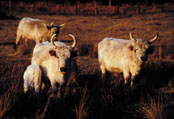Inbreeding, which can lead to the loss of genetic variation or the accumulation of deleterious alleles, has been shown to reduce fitness in wild1, zoo, laboratory2 and farmed3 animals. But it has been proposed that when combined with selection, inbreeding may purge deleterious alleles4. Here we provide support for this hypothesis in a study of the Chillingham cattle, which shows that this viable herd is almost genetically uniform. The homozygosity of this herd far exceeds that of other cattle5 and that found in wild populations of other mammalian species6, 7.
This feral herd, which lives in a park in northern England, is thought to have experienced no immigration for at least 300 years ( Fig. 1). Despite this genetic isolation, records of calvings and deaths suggest that there has been no drop in fertility or viability8. In 1947 the population crashed to five bulls and eight cows; as of 30 October 2000 it numbered 49 individuals. Studies of blood groups and biochemical polymorphisms that represent a small number of genetic loci showed homozygosity for the same alleles at each locus8.
 |
Figure 1
Chillingham cattle (Bos taurus). Full legend High resolution image and legend (57k) |
We obtained tissues from calves, adult cows over 6 years old and bulls that died in 1998–99 (n = 13). Family relationships and causes of death were unknown; there was no evidence of infectious disease. DNA from the samples was scored for 25 microsatellite markers. These markers are highly polymorphic in cattle5, with a heterozygosity of typically 70%, and cover 15 of the 29 autosomes. Three markers are located around the bovine major histocompatability complex (MHC) region, where selection might maintain polymorphism9.
We successfully amplified between 3 and 23 markers for each of the 13 samples, obtaining a total of 225 marker genotypes. (The variation was due to the poor quality of DNA extracted from some hair-root samples.) All samples showed an identical homozygous genotype for 24 of 25 markers. For one marker ( HUJ616 on chromosome 13, amplified or sequenced from 11 samples), nine individuals were heterozygous for the same alleles, and two were homozygous for the same allele, with one allele in common with the heterozygous individuals.
We believe that this single heterozygous marker represents the persistence of
ancestral heterozygosity. Assuming 67 generations since 1700, a coefficient of
variation of 50% in the population size, and a mean number of sires and dams per
generation of 3 and 15, respectively, the effective population size Ne
(ref. 10) averages 8.0, and the expected proportion of
remaining ancestral heterozygosity is [1 - 1/(2Ne)]67
= 0.013. The probability of segregation at a multi-allelic locus with ancestral
heterozygosity of 0.70 after 67 generations is approximately 3 ![]() 0.70
0.70 ![]() [1 - 1/(2Ne)]
67 = 0.028 (ref. 11). Thus the probability of finding
one heterozygous marker out of 25 markers sampled, using the binomial
distribution and assuming unlinked loci, is 0.35, and our data are consistent
with the population having been closed for 300 years.
[1 - 1/(2Ne)]
67 = 0.028 (ref. 11). Thus the probability of finding
one heterozygous marker out of 25 markers sampled, using the binomial
distribution and assuming unlinked loci, is 0.35, and our data are consistent
with the population having been closed for 300 years.
The observed genotype frequencies at the segregating locus are not significantly different from Hardy–Weinberg equilibrium (P = 0.057, exact test). Re-typing, re-scoring, and sequencing the single marker HUJ616 gave the same results, making a procedural artefact or a recent mutation unlikely. Heterozygosity could be maintained by selection. Homozygosity was observed at two linked markers on chromosome 13 (9 and 5 animals typed successfully at each). But these markers were 5 and 3 centimorgans from HUJ616, respectively, too distant to observe a remaining ancestral heterozygous segment.
For the bovine genome (which has a total map distance of 30 morgans — the expected number of crossovers in the genome during meiosis is 30), with random breeding in isolation for 67 generations, initial complete heterozygosity is predicted to result in 30 heterozygous segments with a mean length of only 1.5 centimorgans12. We cannot determine from our data the most likely cause of observed heterozygosity, but it is consistent with the segregation of alleles at a neutral locus in a small population which has been closed for 300 years.
We believe the continuing viability of the herd shows that deleterious alleles have been purged. No chromosome segments appear heterozygous, apart from a single marker. There is no evidence of heterozygosity near the MHC complex, implying that selection by disease or parasites has not been important at this locus, or perhaps that an optimum haplotype has been fixed. The homozygosity of the Chillingham herd might help to elucidate the bovine genome and the genetics of disease resistance13.